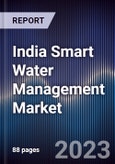The report provides a comprehensive analysis of the potential of the Smart Water Management Industry in India. The report covers an overview and genesis of the industry, and market size on the basis of revenue generated.
Its market segmentation includes by component offered, by user-type, and by geography; growth enablers and drivers; challenges and bottlenecks; trends driving adoption trends; regulatory framework; industry analysis, competitive landscape including competition scenario and market shares of major players. The report concludes with future market projections of each market segmentation and analyst recommendations.
Market Overview:
According to publisher estimates, the India Smart Water Management Market- which grew at a CAGR of 70.9% in the period of 2017-2022P - is expected to grow at a CAGR of 32.2% in the forecasted period of 2022P-2027F, owing to ageing water infrastructure and pressure of population growth, growing water scarcity and need for more optimal allocation, government investments and increasing awareness towards water savings.
The Ministry of Jal Shakti has taken up NHP to establish a hydrological database, information system and scientific tools for effective planning and management of water resources.
With ~10,000 households reached per project on average, states like Andhra Pradesh are leading the adoption of integrated smart water technologies.
There are 433 monitored reservoirs in India, with Gujarat having the most number of reservoirs.
Key Trends by Market Segment:
- By User-Type: Governmental projects dominate the India Smart Water Management Industry currently owning majority of the market share. On the other hand, non-governmental projects only acquire a minimal share of the market
- By Geography: Northern region dominates the India Smart Water Management Market closely followed by the Central region. The slowest adoption of smart water management systems was however seen in the Eastern region
Competitive Landscape
In the India Smart Water Management Market, there are about 20 players operating in the overall market, and top 6 players accounted 91% share in the market in terms of revenue. The major parameters on which these players compete includes Year Established, Major Verticals, Annual Water Management Projects and others.
Future Outlook
The India Smart Water Management Market is projected to show a growth of CAGR 32.2% in the forecasted period of 2022P-2027F, owing to the ageing water infrastructure and pressure of population growth, growing water scarcity and need for more optimal allocation, government investments and increasing awareness towards water savings.
Additional benefits of purchasing an enterprise license:
- TAM/SAM/SOM Analysis
- Customer Cohort Analysis
- Marketing Initiatives
- White Space Opportunity Analysis
- Interactive Data Visualizations
- Customization: 20 Analyst Hours
- 3 Months Post Sales Analyst Support
- Complimentary Update Next Year
- Custom Webinars
Table of Contents
Companies Mentioned (Partial List)
A selection of companies mentioned in this report includes, but is not limited to:
- L&T
- MEIL
- NCC
- JWIL
- JMC
- SPML
- GDCL
- Xylem
- Honeywell
- WEGot
- SUEZ
- Smarter Homes
- Itron
- ABB
- Hitachi Energy
- Enhanced Wapp Systems








